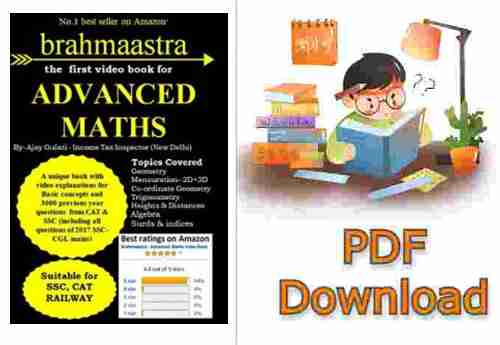Click here to download the pdf
Brahmastra Advanced Maths PDF Download
Details of Brahmastra Advanced Maths Book
- Book Name: Brahmastra Advanced Maths
- Authors: Dr Prerna Bansal
- Pages: 624
- Genre: Study book
- Publish Date: 1 January 2018
- Language: English
Book Review:
The book begins with a brief introduction about Brahmastra Advanced Mathematics, followed by a chapter-by-chapter description of the contents of the book. In the first chapter, we learn about the author and his background. We then move onto the second chapter where
we learn about the history of mathematics. In the third chapter, we learn about different types of numbers. In the fourth chapter, we learn about algebra. In the fifth chapter, we learn about geometry. In the sixth chapter, we learn about trigonometry.
In the seventh chapter, we learn about calculus. In the eighth chapter, we learn about differential equations. In the ninth chapter, we learn about linear algebra. In the tenth chapter, we learn about matrix theory. In the eleventh chapter, we learn about multivariable calculus.
In the twelfth chapter, we learn about complex analysis. In the thirteenth chapter, we learn about number theory.
In the fourteenth chapter, we learn how to solve problems using Brahmastra Advanced Maths. In the fifteenth chapter, we learn some advanced topics in Brahmastra Advanced Mathematics. In the sixteenth chapter, we learn what is Brahmastra Advanced Mathematical Algebra?
In the seventeenth chapter, we learn about Brahmastra Advance Mathematical Geometry. In the eighteenth chapter, we learn about brahmastra advanced maths book review. In the nineteenth chapter, we learn about mathematical proofs.
In the twentieth chapter, we learn about basic concepts in Brahmastra Advance Maths. In the twenty-first chapter, we learn about fundamental theorem of arithmetic. In the twenty-second chapter, we learn about prime factorization. In the twenty-third chapter,
we learn about Euclid's algorithm. In the twenty-fourth chapter, we learn about gcd. In the twenty-fifth chapter, we learn about lcm. In the twenty-sixth chapter, we learn about modular arithmetic. In the twenty seventh chapter, we learn how Brahmastra Advanced Book Review.
In the twenty eight chapter, we learn about congruence. In the twenty nine chapter, we learn about modulus. In the thirty chapter, we learn about divisibility. In the thirty-one chapter, we learn about factoring.
In the thirty two chapter, we learn about polynomial division. In the thirty three chapter, we learn about rational expressions. In the thirty four chapter, we learn about quadratic equation. In the thirty five chapter, we learn about radical expression. In the thirty six chapter, we learn about exponential function. In the thirty seven chapter, we learn about logarithm. In the thirty eight chapter,
we learn how brahmastra advanced math book review. In the thirty nine chapter, we learn how do I use brahmastra advanced mathematics book review.
In the forty chapter, we learn about transcendental numbers. In the forty-one chapter, we learned about Brahmastra advanced book review. In the fourty-two chapter, we learn about real numbers. In the fourty three chapter,
we learn how does brahmastra advanced book reviews work. In the fourty four chapter, we learn how can I use brahmastras advanced book review. In this section, we learn about Brahma Stram Advanced Book Reviews. In the fourty five chapter, we learn how is brahmastra
Mathematics is an intellectual and social construct that has gained immense importance in the last century. It underpins most of our digital systems and concepts.
Many science and engineering tasks require mathematical equations to function; an estimated 95 percent of all tweets are mathematics-based.
Advanced mathematics is a rigorous and complex field that has applications in science, economics and astronomy.
Advanced mathematics is used extensively in science, technology, economics and management. Most sciences, technology and engineering works are based on mathematical equations- such as the square root of minus one or pi- which have been rigorously tested.
In addition, many economic calculations use advanced mathematics to function- such as the subprime housing market or stock market. Individuals who are good at applying mathematical concepts in real life situations are much sought after.
Advanced mathematics is conceptual in nature and relies on logic and thinking to understand. The thinker must be able to grasp abstract concepts such as algorithms, sets, functions and number theory.
Many advanced mathematics concepts are not taught in schools due to their complex nature. Teachers have to be accredited experts in these subjects to impart them to their students.
These subjects help students develop their thinking abilities and may improve their academic performance.
Mathematics is an integral part of many scientific ideas such as calculus, probability, physics and statistics. Scientists use advanced mathematics to perform various calculations such as finding the average height or weight of a group of people.
This application of mathematics helps fuel the development of new scientific discoveries, treatments and food preservation codes. In addition, economists use advanced mathematics when performing economic calculations such as creating price indexes or forecasting market trends.
Many professionals use advanced mathematics in their daily work; this field is very much alive and relevant to everyone.
Mathematics has become more accessible today due to computers, calculators and smartphones. Individuals who are good at applying mathematical concepts in real life situations are much sought after today.
Schools impart advanced mathematics to budding minds so they can understand these concepts better. Hence, it's important for everyone to understand how easy it is to learn and apply mathematics!
Also read: Excel Vba Programming for Dummies Pdf Download
Also read: Black Book Of English Vocabulary PDF Download
Also read: Fast Track Objective Arithmetic by Rajesh Verma PDF
Also read: Indian Polity Pdf for UPSC free Download
Also read: SL Arora Physics Class 12 Pdf, 11 Pdf Download free




Comments
Post a Comment